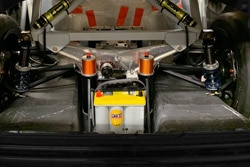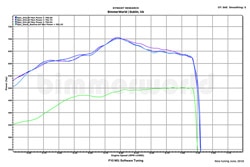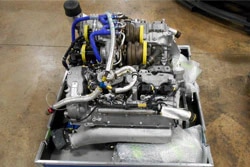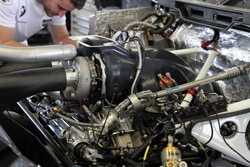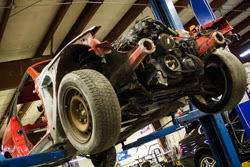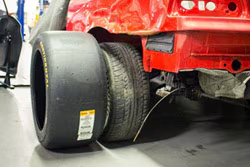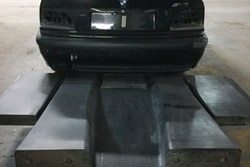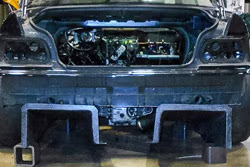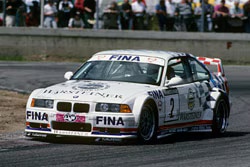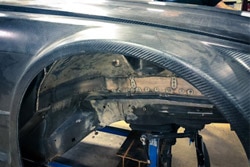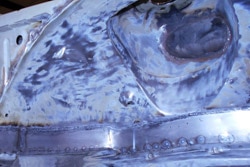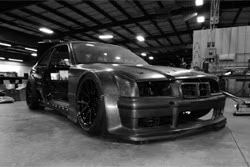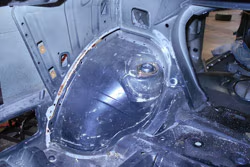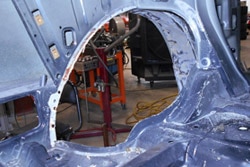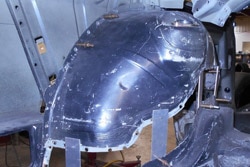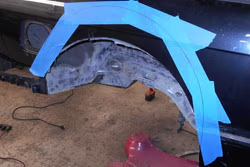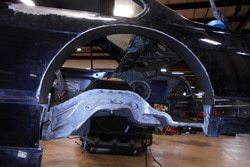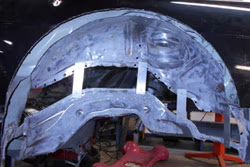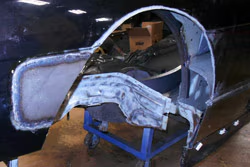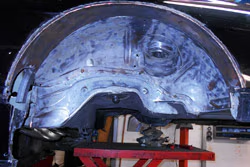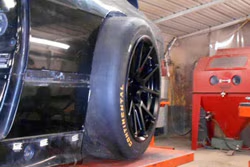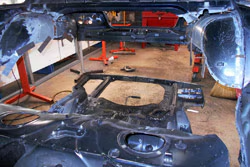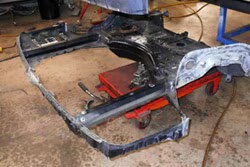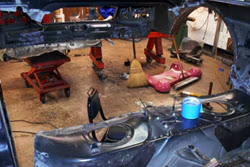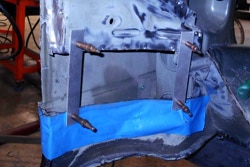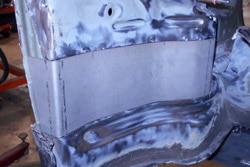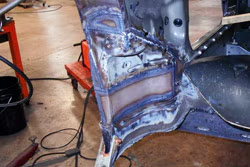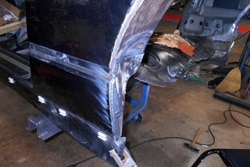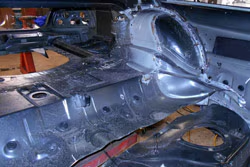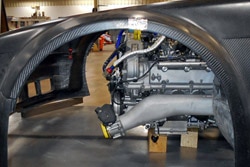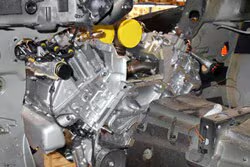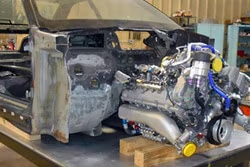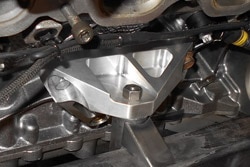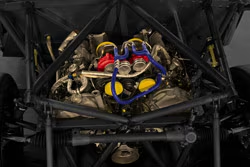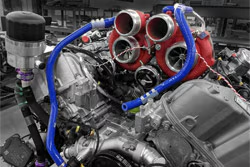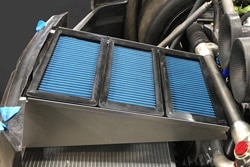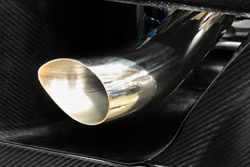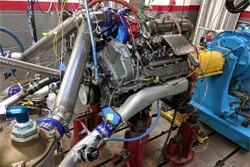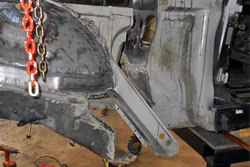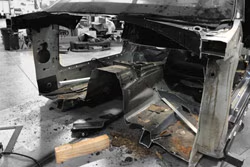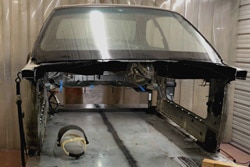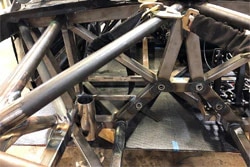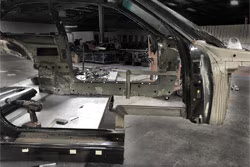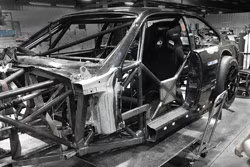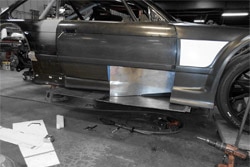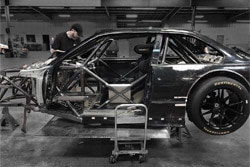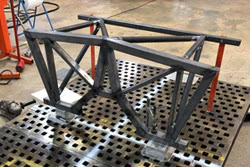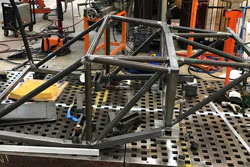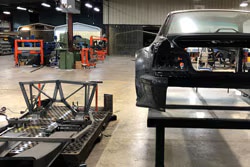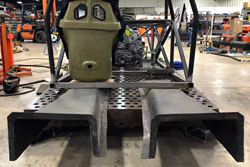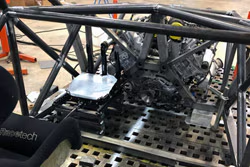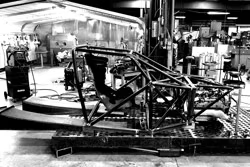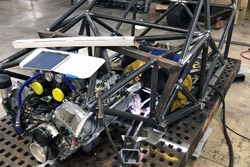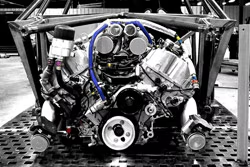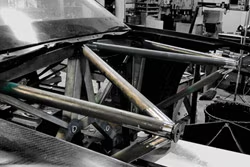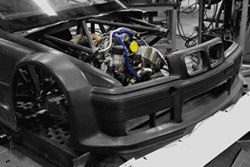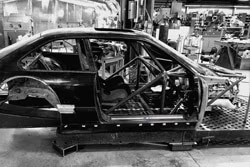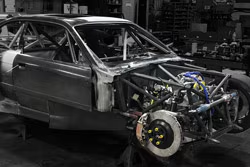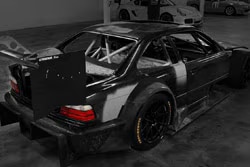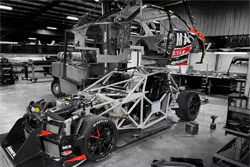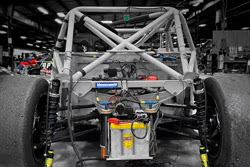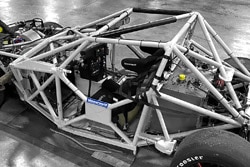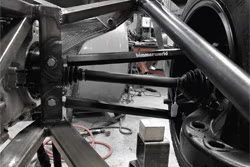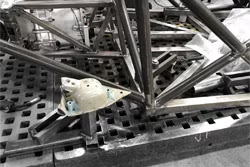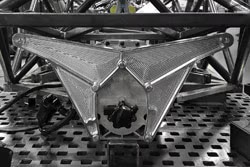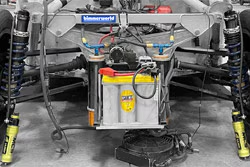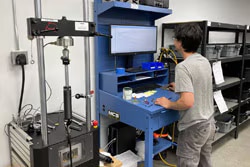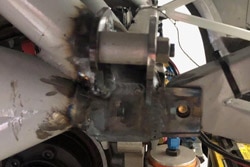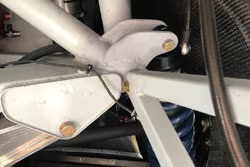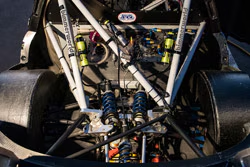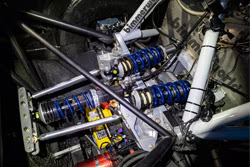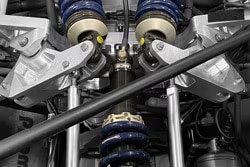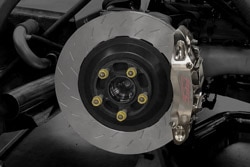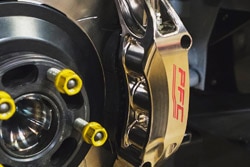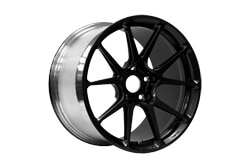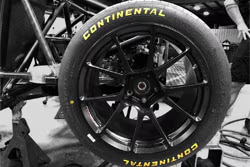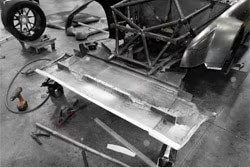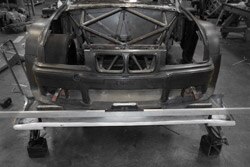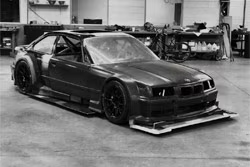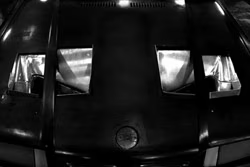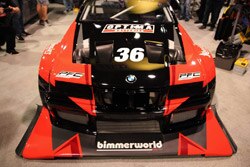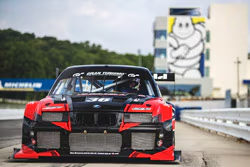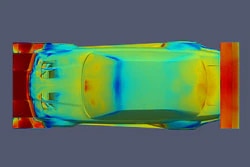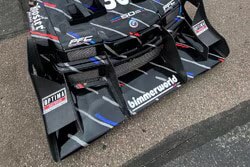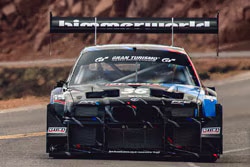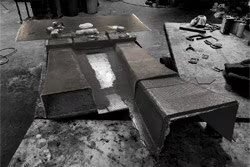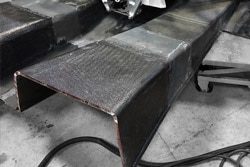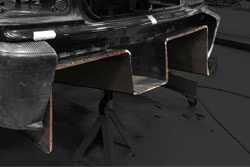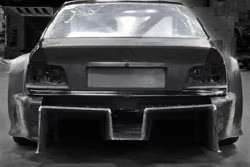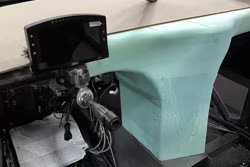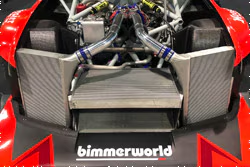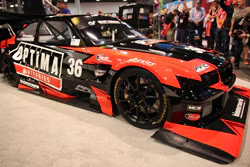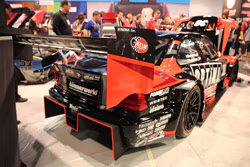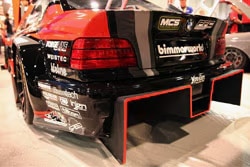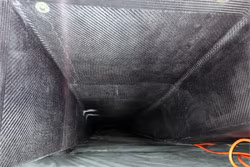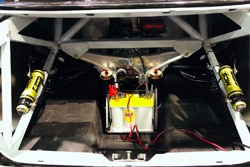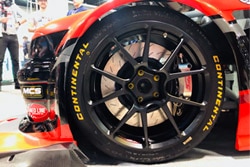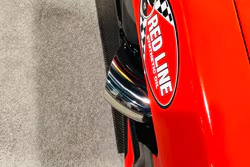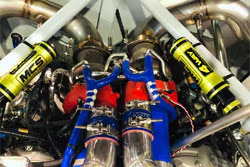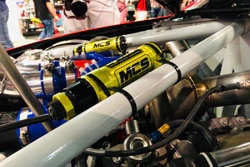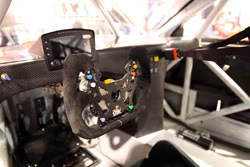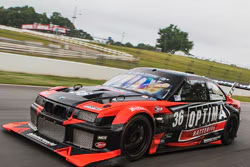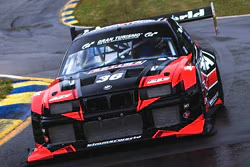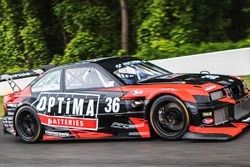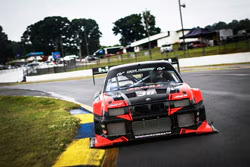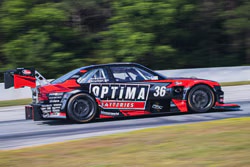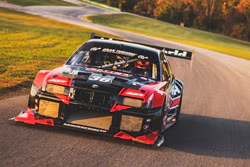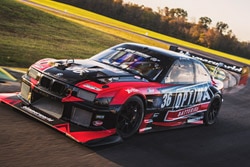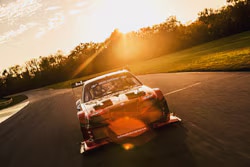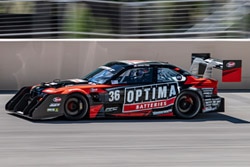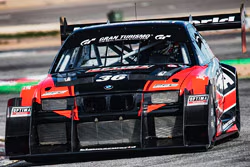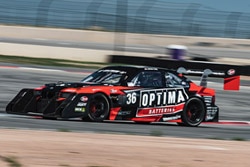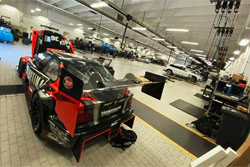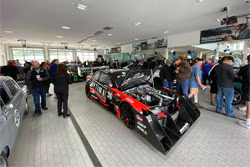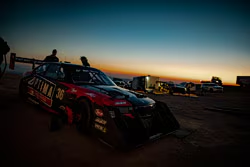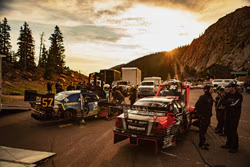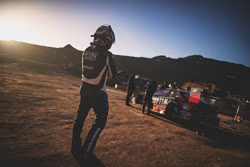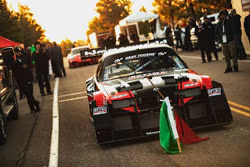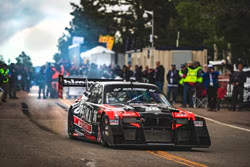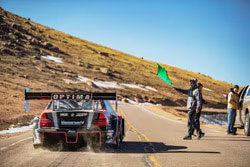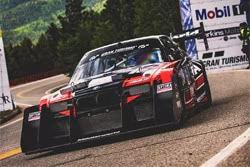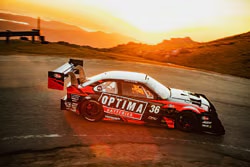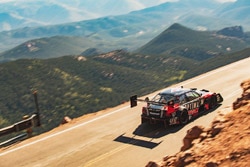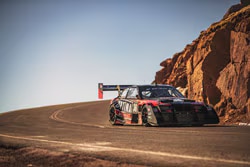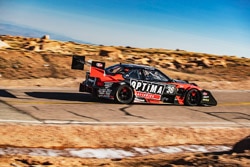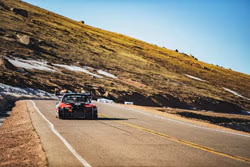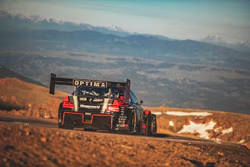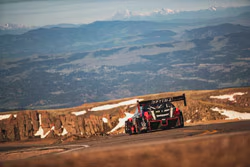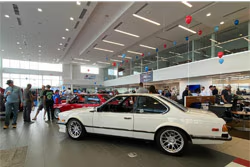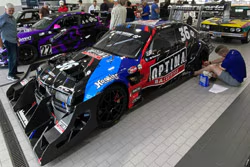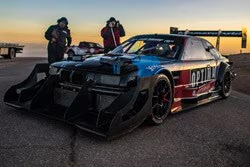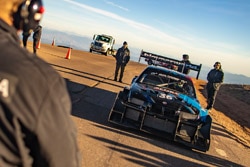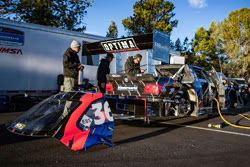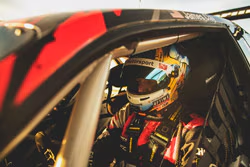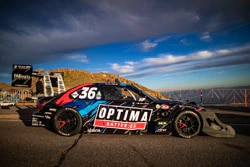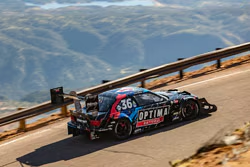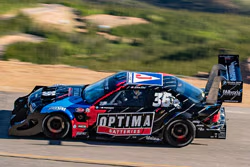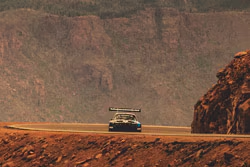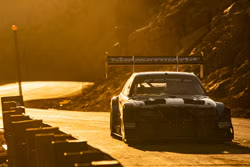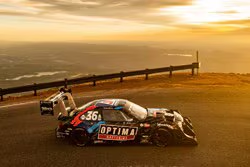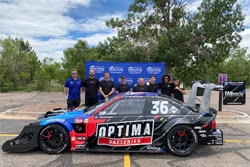|
Bergsteiger E36 Build Journal
Last Update: 12.02.2022
de: "Bergsteiger" : en: Mountaineer, Climber
 Following our inaugural Pikes Peak Hill Climb in 2017 - sixth in class, 11:02.966 - we approach future hillclimb efforts with a renewed appreciation for what it takes to go really, really fast up a mountain. They call it a "hill climb" but the hills are way below us. Don't mistake Pikes Peak as anything but a mountain. This course is 12.42 miles and 156 turns, with a starting line at 9,100 feet above sea level, and an elevation change of 4,720 feet!
Following our inaugural Pikes Peak Hill Climb in 2017 - sixth in class, 11:02.966 - we approach future hillclimb efforts with a renewed appreciation for what it takes to go really, really fast up a mountain. They call it a "hill climb" but the hills are way below us. Don't mistake Pikes Peak as anything but a mountain. This course is 12.42 miles and 156 turns, with a starting line at 9,100 feet above sea level, and an elevation change of 4,720 feet!
The 2017 entry with a E92 M3 was our first attempt at a hill climb car and it met our expectations and performed flawlessly albeit lacking horsepower from a S65 with only bolt-on upgrades. That car was built with specific objectives in mind that were not exactly optimized for a hill climb: a serious contender in the Time Attack 1 class but with many bolt-on upgrades that a weekend track toy would benefit from. That time was 11:02.966. For 2019 we entered one of our F82 M4 GT4 race cars - tuned by Epic Motorsports and improved our time to 10:39.786. For our next entry, however, we have to go beyond the realm of the typical track junkie. We had to crest new heights and strive ever higher in our quest for speed on the mountain.
Yes, it is E36 based.... Yes, it is turbocharged..... Yes, it has mega aero upgrades..... And it's like no other E36 you have seen.
This car is so far advanced from what any other E36 has been that we need more than a year of development for it. Keep checking this page as the months and weeks count down to our future Pikes Peak International Hill Climbs!
The Battery
This project began with a torture test of an OPTIMA battery. One battery used in the most punishing environments a battery would every see: from the Red Rocks of Moab to the Green Hell of the Nurburgring, a single OPTIMA YellowTop battery powered a wide range of vehicles. We used this YellowTop on our first Pikes Peak entry, a BMW E92 M3 and also during the Nurburgring 24 Hour in a BMW M235i Racing. Hooked on the hill climb we set about building a monster of an E36, again with OPTIMA on board.
Engine
Our target power number was over 900hp. At the Pikes Peak altitude we can expect to lose 20% of our output so starting big is key. The original plan called for a monster N54 build with Roush Engines and MOTIV Motorsport. They were well on their way to hitting our target. But then we had a new M6 make 700whp on our dyno with just an Epic Motorsports flash tune (over 800hp at the engine). And that got us seriously re-thinking our choice of powerplant. A tricked out N54 pushing the upper limits of its design. Or a S63TU reaching target power with minimal effort using stock internals and hardware.
As interesting as a monster N54 would be to build and document, the "effortless" power from an S63 was too attractive. But moving from an inline-6 to a V8 presents some obvious additional challenges, the first of which is obviously, "Will it fit?" Other V8 swaps have been done on the E36 but the "hot vee" layout of the BMW S63 makes this fitment more interesting. On the hot vee design the turbos are in the V of the engine block and the intakes are on the sides/bottom. The exhaust runs down the back of the block. In that respect this application is better because we won't need to fabricate intricate headers to fit within the E36 frame rails. The initial test install of the V8 in the E36 engine was promising. The more compact V8 leaves more room in the front, which will be filled with intercoolers and ducting for our aero package.
To learn more about the engine itself we checked in with BMW Motorsport on how the P63 engine in the M6 GT3 and M6 GTLM is laid out. The P63 is the official code for the racing version of the S63 street engine. Most of the differences are in the packaging and support systems as the race engine actually makes equal power to the street version to meet Balance of Performance rules. Through our conversations we were able to get a spare P63 V8 engine sent to us for mockup and development. The P63 would be a better start for our project saving us from engineering and fabricating similar pieces ourselves (fuel and oil systems for example). Much of what we might need is already in the M6 GT3 catalog! And just like the GT3 our E36 will run a transaxle which will further improve space in the engine compartment.
"Hey, I have an idea!"
Body & Aero
Our basic needs are a wide footprint and literally tons of downforce. As anyone who has built an E36 track car knows, it's not easy to fit super-wide tires under stock bodywork so substantial work would be needed on the body and chassis.
E36 #1
Our first E36 candidate was this humble 325is that was offered to us by a customer. The body was rough and although we would be chopping, sectioning, and channeling, it was too sad-looking for us to build upon. We were able to acquire an empty E36 M3 shell that we could start on right away.
E36 #2 - the one that is "just right"
Work begins by eye-balling the IMSA GTP tunnel molds we had kicking around. These were originally used on a Argo GTP Lights car in the 1980s - the pinnacle of aero downforce development. We laid out our carbon fiber and did some further scrutineering on how we're going to get these massive tunnels up into a steel-bodied production car.
A Familiar E36 Shape
On the surface this car looks like a very familiar E36 shape. The widebody panels for this build came from the same molds used for the 1990s E36 M3s raced by Schnitzer Motorsport and Prototype Technology Group. It was hugely important that we get a lot of BMW DNA in this project and what better representative of the E36 legacy than the shape that brought multiple Manufacturers and Drivers titles to BMW. Underneath is a different story altogether as you'll see from the photos below.
Initial E36 Chassis Work
Front Strut Towers Raised & Carbon Fenders Test-Fitted
The front inner fenders and shock towers were relocated upward to lower the chassis for aero effectiveness and to make room for our monster wheels, tires and brakes. A ton of work went into reshaping the strut towers without affecting suspension geometry. Just a little more massaging and it will fit together almost like a stock car!
Update: once the needs of the P63 V8 were realized we had to scrap the modified stock fender wells and construct a tube frame. We left these images here for general interest.
Rear Wheel Wells Raised
Just like the front, we sectioned out the rear wheel wells and raised them up into the body. We have kept the factory sheetmetal here because the floor will also be raised up. Any gaps were covered with sheet steel and the structure was beefed up with square tubing. This is by no means a finished position but check out the ground clearance in the last photo!
Update: once the transaxle, fuel cell, and tunnels were mocked into place we realized we had to scrap the modified stock fender wells and construct a tube frame. We left these images here for general interest.
Raising the Rear Floor
To make room at the back for the tunnels we raised the trunk floor after the back seat to mate to the raised wheel wells. Again, we cut along pre-planned existing seams so that it goes back together like the factory shell. We could have kept the outer skin and fabricated the internals with standard sheet metal but this way retains somewhat of a factory appearance (picture it fully painted).
Update: after test fitting the transaxle, fuel cell, and suspension we had no room for the factory floor section and switched to a tube-frame and sheetmetal. We left these photos here for general interest.
E36 Tube Frame
V8 Engine Mockup in the E36 Chassis
We were fairly sure the N54 inline-6 would fit within the E36 firewall and frame but now we have a hot-vee 90° V8. And did you think we were going to use E36 lower control arms and suspension? We'll have custom MCS dampers mounted to the tube frame. This is where the Bergsteiger project took a radical turn and the engineers said something like, "It's time to get serious." The Motorsport P63 engine has to sit low and rearward for optimum performance. How about we just tube it up?
Firewall and Floor
Since the original E36 engineers didn't think of our P63+transaxle+tunnel project we went ahead and chopped out the pieces that were in the way. The firewall was not strong enough to support the P63 in the proper way. Square tubing will fill its space and form the center of a front tube-frame and interior safety cell.
Tube Frame and Safety Cell
This roll cage structure will provide the strength needed for 1,000+hp as well as the critical safety net around the driver.
Body Shell and Tube Frame Meet
One does not simply build a tube frame within an E36 shell. It takes many mockups to check and re-check clearances, alignments, and to plan for just about everything.
Rear Suspension
2020 Spec
The rear suspension is our tubular aluminum arms mounted to the transaxle but we do have a factory E46 M3 rear trailing arm. This gives us mounting locations for the brakes, axles, and rear shock. It also clears the underfloor tunnels really well. The rear shocks are a custom set of MCS dampers. Pre-event testing at VIR and Road Atlanta gave us plenty of opportunity to experiment with springs and shock settings. But did not prepare us for the surface undulations at the higher Pikes Peak elevations. A new asphalt surface had settled but created huge bumps through most of the course. This required us to lengthen our shock travel, which MCS was happy to work out for us. The longer damper also required a new mount on our chassis, fabricated and installed on the fly.
2022 Spec
Our first layout was fantastic on traditional race tracks and smooth surfaces. But the Pikes Peak auto road is unique and there's very little we can do at sea level to prep and develop for it. So for 2022 we took all that we learned in the previous runs and re-evaluated our rear suspension. There are a lot of small battles going on. We've already mentioned the bumps and dips that require a lot of suspension travel. But the hairpin turns are an additional challenge. We couldn't run a rear sway bar because the bar itself would limit suspension droop travel on these hairpins and affect our ability to put power down. The suspension had to be able to articulate multiple different angles as one side compressed and the other extended. We also had the issue of the tremendous aero downforce (2,000+lbs) pushing the rear springs to compress. We had to think out of the box. Enter the T-bar rear suspension (aka the 3rd spring).
The T-bar design has been around for decades in formula and prototype racing. It's a third damper and spring mounted in the center of the chassis and its job is to absorb the loads from the aero without directly impacting the compliance for the two main springs. As an added feature, the bar can be linked to both rear wheels to act as an anti-roll bar without affecting suspension travel. The aero load is absorbed by the 3rd spring, which then pushes on the two main springs equally but doesn't affect each wheel's travel or compression. As the wheel compresses, the T-bar pivots and releases the suspension on the opposite side, allowing the opposite damper and spring to extend and for the tire to stay in contact with the pavement. It sounds and looks complex but once you follow the force of each component it quickly makes sense.
It also quickly made a huge improvement in our car's behavior on the mountain. A lot of computer simulation gave us a head start before the first 2022 practice runs and we were pleased that the new layout worked as intended and got better with small adjustments after each run.
Brakes
We have the ultimate PFC braking system on this build:
Front: 380mm V3 discs with ZR78 6-piston monoblock GT Endurance calipers. Calipers are massive but weigh only 6.34lbs each! Because it's an Endurance caliper - and pads are super thick - no removable caliper bridge is necessary so the caliper is incredibly stiff.
Rear: 380mm V3 discs with ZR77 4-piston monoblock GT Endurance calipers. Super-sized but weighs only 5.21lbs.
Pads: PFC 11 race compound. We don't need the super-thick 30mm pads but it's a trade-off to get these awesome calipers on the car.
Wheels
Forgeline GS1R Competition Monobloc wheels sized at 18x12" sit at all four corners.
Front Aero V1
This car has the full complement of aero enhancers, inspired by contemporary DTM and LeMans prototype cars. In addition to the massive tunnels under the car, an equally massive front splitter is there to capture air off the nose. The splitter came from a Lola B2K/40 LeMans prototype car. To evacuate air from under the car and the engine bay, side channels were cut through the E36 rocker panels and large vents were built into the hood. Slippery it ain't but dynamic it is!
Front Aero V2
As large as that Lola splitter is, it wasn't quite enough for the thin air of Pikes Peak so the team went back to the drawing board for an overhaul of the front aero. The second round was part of our CFD development work. The Pikes setup is very difficult given the larger suspension travel and higher ride height required. From wind tunnel data and extensive CFD work we determined we needed a raised center section on the leading edge to bring more air under the car, and we added strakes on the underside to direct and control the airflow. The more obvious changes above the splitter improve efficiency and clean up the airflow down the sides of the car and especially how it hits the rear wing, which is critical to front downforce as well as rear.
Rear Aero
One of the core features of this project has been to create substantial downforce to go along with the big power. These tunnels were borrowed from a IMSA Camel Lights race car from the 1980s (when downforce was unlimited). The challenging reality of fitting tunnels to a unibody chassis was not lost on us but required extensive work in the back to make everything fit within the E36 body shell. At first the factory rear floor was going to be raised with the tunnels cut into the backseat and spare tire well. But things escalated from there and it was decided to cut the rear floor out entirely and build from scratch. This had the added benefit of allowing the tunnels to be extended even further. What's better than downforce tunnels on an E36? Longer tunnels of course!
Cockpit & Interior
Cooling
SEMA Unveiling at OPTIMA, November 5, 2019, Las Vegas
Testing Action
Click for extra-large 1920px size.
Winslow BMW Event 2021
Shout-out to Winslow BMW of Colorado Springs for hosting customers, BMW CCA members, and fans before the 2021 Pikes Peak Hill Climb. The Colorado Springs area has a strong a passionate BMW legion and they turned out some extra special cars for this event. They were also very generous to allow us to basecamp there during the pre-event activities. Winslow is a great friend to our team and to the BMW marque!
Pikes Peak International Hill Climb 2021
Pikes Peak is a race against the mountain itself, and we knew 2021 was going to be wicked, due in part to construction of a new visitor’s center at the summit. The road is challenging enough with constant freeze-thaw, often moving several inches overnight. Now construction equipment made it rougher via a daily effort to complete what will be a magnificent structure.
To plan for the bumps we raised the ride height from under two to over three inches, dropped spring rates by half, and added a front sway bar. With more height came a loss of aero performance from underneath so we expanded the upper wing aero. We nearly doubled the square footage of the rear wing and gave the front a massive overhaul.
At the start of testing we ran the upper section, which proved to be just as challenging as expected. My first look at the bumps came from the perspective of shot-out-of-a-cannon at 5:00am. The full car left the ground at least three times in the first run. The team did some quick changes so the tires could maintain contact. These proved to be steps in the correct direction but were now overshadowed by the car’s pivoting 45 degrees at a very prominent dip.
For the rest of testing we worked on ride height, springs (and I mean stacks of three springs, like a dirt car), and shocks. The rest of the car was simply awesome, and we knew it would be good on the much longer bottom section, but we had to decide how much to compromise bump-handling for road-carving.
Testing concluded, we had seven days until race week. Not content with our performance over bumps, we hatched a plan: fly our dampers back to MCS in Atlanta for a change in length and damping curve. Meanwhile, the car landed at a fabrication shop in Boulder. Five days later we had a completely remade rear suspension with a few more inches of travel, more front travel, and the most ridiculous stack of springs I’ve ever used on a “road race” car.
Race week is four days of practice, qualifying, and finally race day on Sunday. We qualified third in class and eighth overall. But race day brought a troubling sight: rain and snow. More than eight inches of snow fell at the summit overnight. Even though crews had been working all night to keep the road clear, the temperature wouldn’t get above freezing and the ice was there to stay.
So for 2021 the Pikes Peak hill climb would be running to the 16 Mile Turnout (elevation 12,780ft), cutting out four miles from the overall course, and no one would see the summit. We were all here to race the mountain but sometimes the mountain throws you an unwelcome curveball. After my anticlimactic third-in-class finish, I’m determined to return for next year’s 100th running with a faster, even more-developed car, ideally some smoother pavement, and a full run to the summit — if the mountain allows.
- James Clay, adapted from the October 2021 issue of Roundel magazine
Pikes Peak 2021 Photos
Pikes Peak 2021 Videos
Pre-event warm-up at PPIR.
Pikes Upper Section test.
Pikes Middle Section test.
Qualifying run.
Pikes Driver POV run.
Pikes Roof Cam run
Winslow BMW Event 2022
Another great BMW party at Winslow BMW of Colorado Springs with a great atmosphere. There was something for everyone inside and out with a lot of vintage BMW machinery, the very latest M cars, and some of Colorado's BMW racers were on hand. The staff at Winslow are amazing champions of the BMW brand and supporters of the local BMW enthusiast scene. We look forward to our visit every year! Thank you Winslow!
Pikes Peak International Hill Climb 2022
Not many racers in the Northern Hemisphere have to deal with the effects of snow in late June - unless you find yourself on Pikes Peak in Colorado at over 9,000ft elevation. The week of the 100th Pikes Peak Hillclimb teased us with bright sun and moderate temperatures. Until race day. Several inches of snow had fallen overnight leaving a damp surface speckled with crusty snow. But late June also brought warmer temperatures and anyone in the snow belt knows that heavy moisture on a cool-ish day means fog. As in: fog-get-it. Visibility down to less than ten feet (see videos below). Which is an awful shame because our E36-inspired Bergsteiger was faster than ever thanks to off-season improvements.
Leading the changes for 2022 was an all-new rear suspension featuring three springs and damper units with rocker arm attachments. Two units operating in a traditional coil over role with the third functioning as an anti-roll bar. The traditional anti-sway bar is a tubular steel. However, a traditional tubular bar would not have played nice with our existing rear suspension, especially on Pikes' hairpins and bumpy surfaces where the bar would actually reduce traction by lifting a tire. Also, our transaxle-tubular arm-aero tunnel rear layout did not allow for one. There are alternatives however and our team quickly implemented the third spring. This design was borrowed from formula cars. The "top" of the 3rd damper is mounted in the middle of a beam. On either end of the beam are rods that are connected to the same rocker arm that each rear main damper uses for main suspension motions. When cornering when one side compresses the other side extends and the 3rd spring is mostly neutral. However, when both rear wheels compress together - such as when accelerating or from downforce - so does the 3rd spring. With our car producing thousands of pounds of downforce this allows that compression to be absorbed by the 3rd spring, with the two main corner springs "free" to work the bumps.
The other big change for 2022 was with the body. At first glance it's the same E36 form we have had since the car was built. But over the Winter we made a new greenhouse from carbon fiber. This dropped the weight by 200lbs but also allowed us to section the body and remove whole sections for easier access. Now we could fully enclose the cockpit from the rear with a better bulkhead. And have a "clamshell" rear window that could be removed for better access to the rear suspension. The front splitter grew in size to the approximate square footage of Luxembourg with a corresponding improvement in front grip.
With output somewhere north of 1,300 we didn't see an immediate need for more power so the P63-based twin-turbo V8 remained unchanged.
Testing of our new suspension took place at a variety of tracks and surfaces but the real test would be on the mountain in reduced air and downforce. We had struggled a bit with understeer but the larger splitter and playing with the aero balance helped quite a bit here. Every test day was a positive step forward. We were pleased that the car was well-sorted and set up early in race week. With beautiful weather and a strong car we relished the coming of race day on Saturday.
Waking up to damp and cloudy conditions on Saturday was an unfortunate turn of events. It had the biggest effect on tire choice and we chose to run our Hoosier rains over full slicks. "I finished the bottom section around seven to nine seconds in the lead and was still up around four seconds on Rhys (Millen) after the middle section," says James Clay. Nearing the top the fog and visibility grew worse by the minute. Pikes and rally stalwart Millen had the advantage of going first and with better weather. By the time Clay got to the finish line his cushion had reversed to a 17 second deficit. Still, it was good for second in class behind the past winner and veteran hill climber. "I don't know that I realistically could have gone faster even if I wanted to and knew what the times were. It was like being blindfolded over half of the section and guessing where to brake and turn," says Clay.
The Bergsteiger is returning to Pikes Peak for its third run in 2023.
Pikes Peak 2022 Photos
Pikes Peak 2022 Videos
Test Days (and beautiful weather!)
Our T-bar anti-roll spring in action!
The road to 2022 race day.
Full on-board run - or why 1,000hp
and rain tires don't play nice.
That fog is getting thicker...
Bonus Videos
Video Walk-Around (4:28)
Dyno Warm-Up and Pulls (2:34)
Shakedown Test and Notes at Road Atlanta (6:41)
Splitter-Cam at COTA (2:59)
Ride-Alongs at COTA (8:08)
Build Summary
1996 BMW E36 M3
Safety
Racetech RT9119 Kevlar seat
Lifeline Zero 360 Novec fire system (plus 1KG handheld)
Schroth 7-point SFI harness
Schroth FIA cockpit nets
OMP 310 ALU GT steering wheel
ATL custom fuel cell
Body
E36 M3 GTR (ALMS) carbon widebody, modified for additional cooling and downforce
Full body underwing meshes a modified Lola BK240 front splitter, custom floor and undertray, and Argo JM19 Camel Lights downforce tunnels. Estimated 3,000+ lbs of downforce.
Race weight: 2,650lbs
Chassis
E36 unibody basis with partial tube frame
Custom double A-arm front
Factory BMW E46 M3 trailing arms with BimmerWorld tubular aluminum rear arms
Custom rocker-arm horizontally-mounted coil overs with T-bar rear anti-roll bar and third spring
MCS 4-way dampers
DCE power steering
Brakes
Performance Friction GT-spec endurance package
Bosch Motorsport ABS
Wheels & Tires
Forgeline GS1R 18x12"
Continental/Hoosier racing slick
Engine
BMW Motorsport P63 (M6 GT3) twin-turbo 4.4-liter V8
Twin Weistec turbos
Built and tuned by Roush Engines using ported heads, forged rods & pistons
Bosch Motorsport ECU
Motec dash and PDM
OPTIMA YellowTop battery
Over 1,000hp with E85 fuel
Driveline
Hollinger 6-speed transaxle (rear mounted)
Paddle-actuated air-shift
Latest updates posted to Facebook: BimmerWorld and James Clay
Merch:
de: "Bergsteiger" : en: Mountaineer, Climber
About Pikes Peak
 Following our inaugural Pikes Peak Hill Climb in 2017 - sixth in class, 11:02.966 - we approach future hillclimb efforts with a renewed appreciation for what it takes to go really, really fast up a mountain. They call it a "hill climb" but the hills are way below us. Don't mistake Pikes Peak as anything but a mountain. This course is 12.42 miles and 156 turns, with a starting line at 9,100 feet above sea level, and an elevation change of 4,720 feet!
Following our inaugural Pikes Peak Hill Climb in 2017 - sixth in class, 11:02.966 - we approach future hillclimb efforts with a renewed appreciation for what it takes to go really, really fast up a mountain. They call it a "hill climb" but the hills are way below us. Don't mistake Pikes Peak as anything but a mountain. This course is 12.42 miles and 156 turns, with a starting line at 9,100 feet above sea level, and an elevation change of 4,720 feet!
The 2017 entry with a E92 M3 was our first attempt at a hill climb car and it met our expectations and performed flawlessly albeit lacking horsepower from a S65 with only bolt-on upgrades. That car was built with specific objectives in mind that were not exactly optimized for a hill climb: a serious contender in the Time Attack 1 class but with many bolt-on upgrades that a weekend track toy would benefit from. That time was 11:02.966. For 2019 we entered one of our F82 M4 GT4 race cars - tuned by Epic Motorsports and improved our time to 10:39.786. For our next entry, however, we have to go beyond the realm of the typical track junkie. We had to crest new heights and strive ever higher in our quest for speed on the mountain.
Yes, it is E36 based.... Yes, it is turbocharged..... Yes, it has mega aero upgrades..... And it's like no other E36 you have seen.
This car is so far advanced from what any other E36 has been that we need more than a year of development for it. Keep checking this page as the months and weeks count down to our future Pikes Peak International Hill Climbs!
The Battery
This project began with a torture test of an OPTIMA battery. One battery used in the most punishing environments a battery would every see: from the Red Rocks of Moab to the Green Hell of the Nurburgring, a single OPTIMA YellowTop battery powered a wide range of vehicles. We used this YellowTop on our first Pikes Peak entry, a BMW E92 M3 and also during the Nurburgring 24 Hour in a BMW M235i Racing. Hooked on the hill climb we set about building a monster of an E36, again with OPTIMA on board.
Engine
Our target power number was over 900hp. At the Pikes Peak altitude we can expect to lose 20% of our output so starting big is key. The original plan called for a monster N54 build with Roush Engines and MOTIV Motorsport. They were well on their way to hitting our target. But then we had a new M6 make 700whp on our dyno with just an Epic Motorsports flash tune (over 800hp at the engine). And that got us seriously re-thinking our choice of powerplant. A tricked out N54 pushing the upper limits of its design. Or a S63TU reaching target power with minimal effort using stock internals and hardware.
As interesting as a monster N54 would be to build and document, the "effortless" power from an S63 was too attractive. But moving from an inline-6 to a V8 presents some obvious additional challenges, the first of which is obviously, "Will it fit?" Other V8 swaps have been done on the E36 but the "hot vee" layout of the BMW S63 makes this fitment more interesting. On the hot vee design the turbos are in the V of the engine block and the intakes are on the sides/bottom. The exhaust runs down the back of the block. In that respect this application is better because we won't need to fabricate intricate headers to fit within the E36 frame rails. The initial test install of the V8 in the E36 engine was promising. The more compact V8 leaves more room in the front, which will be filled with intercoolers and ducting for our aero package.
To learn more about the engine itself we checked in with BMW Motorsport on how the P63 engine in the M6 GT3 and M6 GTLM is laid out. The P63 is the official code for the racing version of the S63 street engine. Most of the differences are in the packaging and support systems as the race engine actually makes equal power to the street version to meet Balance of Performance rules. Through our conversations we were able to get a spare P63 V8 engine sent to us for mockup and development. The P63 would be a better start for our project saving us from engineering and fabricating similar pieces ourselves (fuel and oil systems for example). Much of what we might need is already in the M6 GT3 catalog! And just like the GT3 our E36 will run a transaxle which will further improve space in the engine compartment.
"Hey, I have an idea!"
Body & Aero
Our basic needs are a wide footprint and literally tons of downforce. As anyone who has built an E36 track car knows, it's not easy to fit super-wide tires under stock bodywork so substantial work would be needed on the body and chassis.
E36 #1
Our first E36 candidate was this humble 325is that was offered to us by a customer. The body was rough and although we would be chopping, sectioning, and channeling, it was too sad-looking for us to build upon. We were able to acquire an empty E36 M3 shell that we could start on right away.
E36 #2 - the one that is "just right"
Work begins by eye-balling the IMSA GTP tunnel molds we had kicking around. These were originally used on a Argo GTP Lights car in the 1980s - the pinnacle of aero downforce development. We laid out our carbon fiber and did some further scrutineering on how we're going to get these massive tunnels up into a steel-bodied production car.
A Familiar E36 Shape
On the surface this car looks like a very familiar E36 shape. The widebody panels for this build came from the same molds used for the 1990s E36 M3s raced by Schnitzer Motorsport and Prototype Technology Group. It was hugely important that we get a lot of BMW DNA in this project and what better representative of the E36 legacy than the shape that brought multiple Manufacturers and Drivers titles to BMW. Underneath is a different story altogether as you'll see from the photos below.
Initial E36 Chassis Work
Front Strut Towers Raised & Carbon Fenders Test-Fitted
The front inner fenders and shock towers were relocated upward to lower the chassis for aero effectiveness and to make room for our monster wheels, tires and brakes. A ton of work went into reshaping the strut towers without affecting suspension geometry. Just a little more massaging and it will fit together almost like a stock car!
Update: once the needs of the P63 V8 were realized we had to scrap the modified stock fender wells and construct a tube frame. We left these images here for general interest.
Rear Wheel Wells Raised
Just like the front, we sectioned out the rear wheel wells and raised them up into the body. We have kept the factory sheetmetal here because the floor will also be raised up. Any gaps were covered with sheet steel and the structure was beefed up with square tubing. This is by no means a finished position but check out the ground clearance in the last photo!
Update: once the transaxle, fuel cell, and tunnels were mocked into place we realized we had to scrap the modified stock fender wells and construct a tube frame. We left these images here for general interest.
Raising the Rear Floor
To make room at the back for the tunnels we raised the trunk floor after the back seat to mate to the raised wheel wells. Again, we cut along pre-planned existing seams so that it goes back together like the factory shell. We could have kept the outer skin and fabricated the internals with standard sheet metal but this way retains somewhat of a factory appearance (picture it fully painted).
Update: after test fitting the transaxle, fuel cell, and suspension we had no room for the factory floor section and switched to a tube-frame and sheetmetal. We left these photos here for general interest.
E36 Tube Frame
V8 Engine Mockup in the E36 Chassis
We were fairly sure the N54 inline-6 would fit within the E36 firewall and frame but now we have a hot-vee 90° V8. And did you think we were going to use E36 lower control arms and suspension? We'll have custom MCS dampers mounted to the tube frame. This is where the Bergsteiger project took a radical turn and the engineers said something like, "It's time to get serious." The Motorsport P63 engine has to sit low and rearward for optimum performance. How about we just tube it up?
Firewall and Floor
Since the original E36 engineers didn't think of our P63+transaxle+tunnel project we went ahead and chopped out the pieces that were in the way. The firewall was not strong enough to support the P63 in the proper way. Square tubing will fill its space and form the center of a front tube-frame and interior safety cell.
Tube Frame and Safety Cell
This roll cage structure will provide the strength needed for 1,000+hp as well as the critical safety net around the driver.
Body Shell and Tube Frame Meet
One does not simply build a tube frame within an E36 shell. It takes many mockups to check and re-check clearances, alignments, and to plan for just about everything.
Rear Suspension
2020 Spec
The rear suspension is our tubular aluminum arms mounted to the transaxle but we do have a factory E46 M3 rear trailing arm. This gives us mounting locations for the brakes, axles, and rear shock. It also clears the underfloor tunnels really well. The rear shocks are a custom set of MCS dampers. Pre-event testing at VIR and Road Atlanta gave us plenty of opportunity to experiment with springs and shock settings. But did not prepare us for the surface undulations at the higher Pikes Peak elevations. A new asphalt surface had settled but created huge bumps through most of the course. This required us to lengthen our shock travel, which MCS was happy to work out for us. The longer damper also required a new mount on our chassis, fabricated and installed on the fly.
2022 Spec
Our first layout was fantastic on traditional race tracks and smooth surfaces. But the Pikes Peak auto road is unique and there's very little we can do at sea level to prep and develop for it. So for 2022 we took all that we learned in the previous runs and re-evaluated our rear suspension. There are a lot of small battles going on. We've already mentioned the bumps and dips that require a lot of suspension travel. But the hairpin turns are an additional challenge. We couldn't run a rear sway bar because the bar itself would limit suspension droop travel on these hairpins and affect our ability to put power down. The suspension had to be able to articulate multiple different angles as one side compressed and the other extended. We also had the issue of the tremendous aero downforce (2,000+lbs) pushing the rear springs to compress. We had to think out of the box. Enter the T-bar rear suspension (aka the 3rd spring).
The T-bar design has been around for decades in formula and prototype racing. It's a third damper and spring mounted in the center of the chassis and its job is to absorb the loads from the aero without directly impacting the compliance for the two main springs. As an added feature, the bar can be linked to both rear wheels to act as an anti-roll bar without affecting suspension travel. The aero load is absorbed by the 3rd spring, which then pushes on the two main springs equally but doesn't affect each wheel's travel or compression. As the wheel compresses, the T-bar pivots and releases the suspension on the opposite side, allowing the opposite damper and spring to extend and for the tire to stay in contact with the pavement. It sounds and looks complex but once you follow the force of each component it quickly makes sense.
It also quickly made a huge improvement in our car's behavior on the mountain. A lot of computer simulation gave us a head start before the first 2022 practice runs and we were pleased that the new layout worked as intended and got better with small adjustments after each run.
Brakes
We have the ultimate PFC braking system on this build:
Front: 380mm V3 discs with ZR78 6-piston monoblock GT Endurance calipers. Calipers are massive but weigh only 6.34lbs each! Because it's an Endurance caliper - and pads are super thick - no removable caliper bridge is necessary so the caliper is incredibly stiff.
Rear: 380mm V3 discs with ZR77 4-piston monoblock GT Endurance calipers. Super-sized but weighs only 5.21lbs.
Pads: PFC 11 race compound. We don't need the super-thick 30mm pads but it's a trade-off to get these awesome calipers on the car.
Wheels
Forgeline GS1R Competition Monobloc wheels sized at 18x12" sit at all four corners.
Front Aero V1
This car has the full complement of aero enhancers, inspired by contemporary DTM and LeMans prototype cars. In addition to the massive tunnels under the car, an equally massive front splitter is there to capture air off the nose. The splitter came from a Lola B2K/40 LeMans prototype car. To evacuate air from under the car and the engine bay, side channels were cut through the E36 rocker panels and large vents were built into the hood. Slippery it ain't but dynamic it is!
Front Aero V2
As large as that Lola splitter is, it wasn't quite enough for the thin air of Pikes Peak so the team went back to the drawing board for an overhaul of the front aero. The second round was part of our CFD development work. The Pikes setup is very difficult given the larger suspension travel and higher ride height required. From wind tunnel data and extensive CFD work we determined we needed a raised center section on the leading edge to bring more air under the car, and we added strakes on the underside to direct and control the airflow. The more obvious changes above the splitter improve efficiency and clean up the airflow down the sides of the car and especially how it hits the rear wing, which is critical to front downforce as well as rear.
Rear Aero
One of the core features of this project has been to create substantial downforce to go along with the big power. These tunnels were borrowed from a IMSA Camel Lights race car from the 1980s (when downforce was unlimited). The challenging reality of fitting tunnels to a unibody chassis was not lost on us but required extensive work in the back to make everything fit within the E36 body shell. At first the factory rear floor was going to be raised with the tunnels cut into the backseat and spare tire well. But things escalated from there and it was decided to cut the rear floor out entirely and build from scratch. This had the added benefit of allowing the tunnels to be extended even further. What's better than downforce tunnels on an E36? Longer tunnels of course!
Cockpit & Interior
Cooling
SEMA Unveiling at OPTIMA, November 5, 2019, Las Vegas
Testing Action
Click for extra-large 1920px size.
Winslow BMW Event 2021
Shout-out to Winslow BMW of Colorado Springs for hosting customers, BMW CCA members, and fans before the 2021 Pikes Peak Hill Climb. The Colorado Springs area has a strong a passionate BMW legion and they turned out some extra special cars for this event. They were also very generous to allow us to basecamp there during the pre-event activities. Winslow is a great friend to our team and to the BMW marque!
Pikes Peak International Hill Climb 2021
Pikes Peak is a race against the mountain itself, and we knew 2021 was going to be wicked, due in part to construction of a new visitor’s center at the summit. The road is challenging enough with constant freeze-thaw, often moving several inches overnight. Now construction equipment made it rougher via a daily effort to complete what will be a magnificent structure.
To plan for the bumps we raised the ride height from under two to over three inches, dropped spring rates by half, and added a front sway bar. With more height came a loss of aero performance from underneath so we expanded the upper wing aero. We nearly doubled the square footage of the rear wing and gave the front a massive overhaul.
At the start of testing we ran the upper section, which proved to be just as challenging as expected. My first look at the bumps came from the perspective of shot-out-of-a-cannon at 5:00am. The full car left the ground at least three times in the first run. The team did some quick changes so the tires could maintain contact. These proved to be steps in the correct direction but were now overshadowed by the car’s pivoting 45 degrees at a very prominent dip.
For the rest of testing we worked on ride height, springs (and I mean stacks of three springs, like a dirt car), and shocks. The rest of the car was simply awesome, and we knew it would be good on the much longer bottom section, but we had to decide how much to compromise bump-handling for road-carving.
Testing concluded, we had seven days until race week. Not content with our performance over bumps, we hatched a plan: fly our dampers back to MCS in Atlanta for a change in length and damping curve. Meanwhile, the car landed at a fabrication shop in Boulder. Five days later we had a completely remade rear suspension with a few more inches of travel, more front travel, and the most ridiculous stack of springs I’ve ever used on a “road race” car.
Race week is four days of practice, qualifying, and finally race day on Sunday. We qualified third in class and eighth overall. But race day brought a troubling sight: rain and snow. More than eight inches of snow fell at the summit overnight. Even though crews had been working all night to keep the road clear, the temperature wouldn’t get above freezing and the ice was there to stay.
So for 2021 the Pikes Peak hill climb would be running to the 16 Mile Turnout (elevation 12,780ft), cutting out four miles from the overall course, and no one would see the summit. We were all here to race the mountain but sometimes the mountain throws you an unwelcome curveball. After my anticlimactic third-in-class finish, I’m determined to return for next year’s 100th running with a faster, even more-developed car, ideally some smoother pavement, and a full run to the summit — if the mountain allows.
- James Clay, adapted from the October 2021 issue of Roundel magazine
Pikes Peak 2021 Photos
Pikes Peak 2021 Videos
Pre-event warm-up at PPIR.
Pikes Upper Section test.
Pikes Middle Section test.
Qualifying run.
Pikes Driver POV run.
Pikes Roof Cam run
Winslow BMW Event 2022
Another great BMW party at Winslow BMW of Colorado Springs with a great atmosphere. There was something for everyone inside and out with a lot of vintage BMW machinery, the very latest M cars, and some of Colorado's BMW racers were on hand. The staff at Winslow are amazing champions of the BMW brand and supporters of the local BMW enthusiast scene. We look forward to our visit every year! Thank you Winslow!
Pikes Peak International Hill Climb 2022
Not many racers in the Northern Hemisphere have to deal with the effects of snow in late June - unless you find yourself on Pikes Peak in Colorado at over 9,000ft elevation. The week of the 100th Pikes Peak Hillclimb teased us with bright sun and moderate temperatures. Until race day. Several inches of snow had fallen overnight leaving a damp surface speckled with crusty snow. But late June also brought warmer temperatures and anyone in the snow belt knows that heavy moisture on a cool-ish day means fog. As in: fog-get-it. Visibility down to less than ten feet (see videos below). Which is an awful shame because our E36-inspired Bergsteiger was faster than ever thanks to off-season improvements.
Leading the changes for 2022 was an all-new rear suspension featuring three springs and damper units with rocker arm attachments. Two units operating in a traditional coil over role with the third functioning as an anti-roll bar. The traditional anti-sway bar is a tubular steel. However, a traditional tubular bar would not have played nice with our existing rear suspension, especially on Pikes' hairpins and bumpy surfaces where the bar would actually reduce traction by lifting a tire. Also, our transaxle-tubular arm-aero tunnel rear layout did not allow for one. There are alternatives however and our team quickly implemented the third spring. This design was borrowed from formula cars. The "top" of the 3rd damper is mounted in the middle of a beam. On either end of the beam are rods that are connected to the same rocker arm that each rear main damper uses for main suspension motions. When cornering when one side compresses the other side extends and the 3rd spring is mostly neutral. However, when both rear wheels compress together - such as when accelerating or from downforce - so does the 3rd spring. With our car producing thousands of pounds of downforce this allows that compression to be absorbed by the 3rd spring, with the two main corner springs "free" to work the bumps.
The other big change for 2022 was with the body. At first glance it's the same E36 form we have had since the car was built. But over the Winter we made a new greenhouse from carbon fiber. This dropped the weight by 200lbs but also allowed us to section the body and remove whole sections for easier access. Now we could fully enclose the cockpit from the rear with a better bulkhead. And have a "clamshell" rear window that could be removed for better access to the rear suspension. The front splitter grew in size to the approximate square footage of Luxembourg with a corresponding improvement in front grip.
With output somewhere north of 1,300 we didn't see an immediate need for more power so the P63-based twin-turbo V8 remained unchanged.
Testing of our new suspension took place at a variety of tracks and surfaces but the real test would be on the mountain in reduced air and downforce. We had struggled a bit with understeer but the larger splitter and playing with the aero balance helped quite a bit here. Every test day was a positive step forward. We were pleased that the car was well-sorted and set up early in race week. With beautiful weather and a strong car we relished the coming of race day on Saturday.
Waking up to damp and cloudy conditions on Saturday was an unfortunate turn of events. It had the biggest effect on tire choice and we chose to run our Hoosier rains over full slicks. "I finished the bottom section around seven to nine seconds in the lead and was still up around four seconds on Rhys (Millen) after the middle section," says James Clay. Nearing the top the fog and visibility grew worse by the minute. Pikes and rally stalwart Millen had the advantage of going first and with better weather. By the time Clay got to the finish line his cushion had reversed to a 17 second deficit. Still, it was good for second in class behind the past winner and veteran hill climber. "I don't know that I realistically could have gone faster even if I wanted to and knew what the times were. It was like being blindfolded over half of the section and guessing where to brake and turn," says Clay.
The Bergsteiger is returning to Pikes Peak for its third run in 2023.
Pikes Peak 2022 Photos
Pikes Peak 2022 Videos
Test Days (and beautiful weather!)
Our T-bar anti-roll spring in action!
The road to 2022 race day.
Full on-board run - or why 1,000hp
and rain tires don't play nice.
That fog is getting thicker...
Bonus Videos
Video Walk-Around (4:28)
Dyno Warm-Up and Pulls (2:34)
Shakedown Test and Notes at Road Atlanta (6:41)
Splitter-Cam at COTA (2:59)
Ride-Alongs at COTA (8:08)
Build Summary
1996 BMW E36 M3
Safety
Racetech RT9119 Kevlar seat
Lifeline Zero 360 Novec fire system (plus 1KG handheld)
Schroth 7-point SFI harness
Schroth FIA cockpit nets
OMP 310 ALU GT steering wheel
ATL custom fuel cell
Body
E36 M3 GTR (ALMS) carbon widebody, modified for additional cooling and downforce
Full body underwing meshes a modified Lola BK240 front splitter, custom floor and undertray, and Argo JM19 Camel Lights downforce tunnels. Estimated 3,000+ lbs of downforce.
Race weight: 2,650lbs
Chassis
E36 unibody basis with partial tube frame
Custom double A-arm front
Factory BMW E46 M3 trailing arms with BimmerWorld tubular aluminum rear arms
Custom rocker-arm horizontally-mounted coil overs with T-bar rear anti-roll bar and third spring
MCS 4-way dampers
DCE power steering
Brakes
Performance Friction GT-spec endurance package
Bosch Motorsport ABS
Wheels & Tires
Forgeline GS1R 18x12"
Continental/Hoosier racing slick
Engine
BMW Motorsport P63 (M6 GT3) twin-turbo 4.4-liter V8
Twin Weistec turbos
Built and tuned by Roush Engines using ported heads, forged rods & pistons
Bosch Motorsport ECU
Motec dash and PDM
OPTIMA YellowTop battery
Over 1,000hp with E85 fuel
Driveline
Hollinger 6-speed transaxle (rear mounted)
Paddle-actuated air-shift
Latest updates posted to Facebook: BimmerWorld and James Clay
Merch:
| Sort by Name | Sort by Price |


